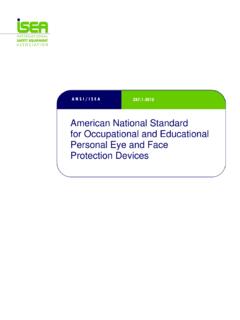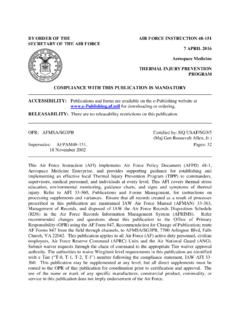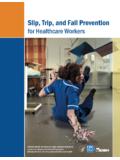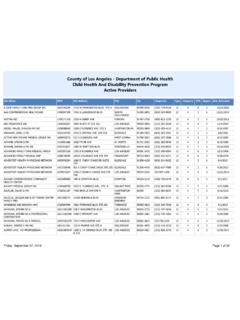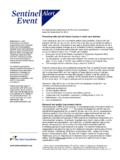Transcription of PERSONAL FALL PROTECTION EQUIPMENT
1 PERSONAL . fall PROTECTION . EQUIPMENT . USE AND SELECTION GUIDE. FOREWORD. a comprehensive fall PROTECTION program prevents injuries, saves lives and makes good business sense. In almost every industry, there are areas where workers are subjected to fall hazards. The 635 fatal falls in 2010 resulted in billions of dollars in workers-compensation costs. Accord- ing to Liberty Mutual, the leading private provider of workers' compensation insurance in the United States, on-the-job injuries cost employers nearly $1 billion per week in payments to injured employees and their medical providers. Developing and implementing comprehensive fall PROTECTION programs in the workplace can prevent many of these injuries and fatalities. Once fall hazards have been identified by a competent person, fall hazard elimination should be considered first.
2 This is typically known as engineering out the hazard and con- sists of redesigning the working environment and the work processes and procedures. If this is impractical due to extensive modifications and cost, fall prevention should be consid- ered next. fall prevention may be handled in a number of ways. Scaffolds, handrails, barriers and movable platforms can be constructed to protect workers employed at heights. Where these devices are impractical, PERSONAL fall PROTECTION EQUIPMENT such as full body harnesses, lanyards and retractable lifelines may be used. The Occupational Safety and Health Administration (OSHA) requires PERSONAL fall PROTECTION for workers at various heights depending on the job. The International Safety EQUIPMENT Association has prepared this use and selection guide to provide practical, hands-on guidance for fall PROTECTION users and administrators in their selection, use, maintenance and inspection of fall PROTECTION EQUIPMENT .
3 Information in this guide is based on OSHA regulations and ANSI standards pertaining to fall PROTECTION , and was provided by members of the ISEA fall PROTECTION Group. The guide is available online as a pdf file on ISEA's Web site, It may be accessed online, or downloaded without charge. The guide will be updated periodi- cally, and the effective date will be shown on this page. If you download the guide, check back periodically to ensure you have the latest edition. For additional information on specific PERSONAL fall PROTECTION EQUIPMENT , contact the manu- facturer of the fall PROTECTION used in your workplace. Edition No. 1. October 2011. Updated February 2015. ISEA USE AND SELECTION GUIDE PERSONAL fall PROTECTION EQUIPMENT 1. CONTENTS. 1. PURPOSE AND SCOPE. Purpose .. 3. Scope .. 3. 2. DEVELOPING A COPORATE PROGRAM FOR SAFETY AT HEIGHT.
4 How Do I Get Started? .. 4. Understanding Regulations and Standards .. 5. Hazard Identification .. 5. Written fall PROTECTION Plan .. 5. Product Selection .. 6. Training .. 6. Role of Competent and Qualified Persons .. 7. 3. COMPONENTS OF A PERSONAL fall PROTECTION SYSTEM. Anchorage/Anchorage Connector .. 8. Body Support .. 8. Means of Connection .. 9. 4. SELECTION OF PERSONAL fall PROTECTION EQUIPMENT . fall Arrest .. 10. Work Positioning .. 10. Restraint .. 10. Suspension/Personnel Riding Systems .. 11. 11. Ladder Climbing .. 11. Evacuation/Controlled Descent Systems .. 12. 5. PLANNING THE USE OF SYSTEMS. First Steps .. 14. Anchorage and Anchorage Systems .. 14. Free fall Distance, Total fall Distance and System Elongation .. 15. User Movements .. 15. Pendulum (Swing) Falls .. 16. Clear Space in fall Path.
5 16. Rescue and Evacuation .. 16. 6. INSPECTION OF fall PROTECTION EQUIPMENT . Harness and Body Belt 17. Lanyard 18. Self-Retracting Lifeline Inspection .. 18. 7. CLEANING, MAINTENANCE AND STORAGE .. 20. 8. DEFINITIONS .. 21. 9. REGULATIONS AND STANDARDS. OSHA Regulations - Title 29 of the Code of Federal Regulations .. 25. Relevant Consensus Standards .. 26. 10. ISEA fall PROTECTION MANUFACTURERS .. 27. 11. FOR MORE INFORMATION .. 28. ISEA USE AND SELECTION GUIDE PERSONAL fall PROTECTION EQUIPMENT 2. 1. PURPOSE AND SCOPE. PURPOSE The purpose of this user's guide is to: Provide guidance to users on the need for proper fall PROTECTION planning to either re- move the fall hazard, prevent access to the fall hazard, restrict worker movement at the fall hazard, or provide the proper fall arrest EQUIPMENT .
6 Illustrate fall PROTECTION systems;. Familiarize fall PROTECTION EQUIPMENT users with the appropriate OSHA and ANSI stan- dards pertaining to their use. Assist in the proper selection, care, use and inspection of fall PROTECTION EQUIPMENT . For specific applications, users should always consult the individual manufacturer's guide- lines. SCOPE These guidelines are written for all PERSONAL fall PROTECTION EQUIPMENT users. This includes those responsible for establishing and administering an employer's fall PROTECTION program. Everyone involved needs to be knowledgeable about fall PROTECTION . Section 2 provides an overview of an enterprise program for safety at heights. Section 3 describes the components of a PERSONAL fall PROTECTION system. Section 4 goes into greater detail, listing typical components for various work scenarios and applications.
7 Section 5 provides guidelines for planning the use of fall PROTECTION systems. Section 6 details how to inspect the components of a fall PROTECTION system. Section 7 gives guidelines for cleaning, maintenance and storage. Section 8 contains definitions for terms used in fall PROTECTION . Section 9 provides a list and links to OSHA and consensus standards. Section 10 is a directory of members of the ISEA fall PROTECTION Group. Section 11 contains links to additional sources of information on fall PROTECTION stan- dards and regulation. ISEA USE AND SELECTION GUIDE PERSONAL fall PROTECTION EQUIPMENT 3. 2. DEVELOPING A CORPORATE PROGRAM FOR SAFETY AT HEIGHT. HOW DO I GET It is the employer's responsibility to develop a fall PROTECTION program that complies with STARTED? mandatory regulations. The most effective programs are those where employers work closely with their workers to identify fall hazards and to jointly develop a comprehensive fall PROTECTION program that either eliminates fall hazards or provides appropriate PROTECTION against them.
8 Employees must also use EQUIPMENT in the manner described by the manu- facturer. The following is an example flow chart of a corporate program for safety at height. Draft corporate Review policy corporate policy Requisition Survey fall Train and EQUIPMENT and hazards retrain perform work workforce IAW policy, procedures and Identify Train/retrain training hazards instructors and supervisors Provide EQUIPMENT Analyze Specify hazards training Corporate Classify Specify policy and hazards procedures procedures manual Specify system Specify requirements Fabricate and EQUIPMENT install engineered NO systems fall PROTECTION Require an category engineered system? YES. fall PROTECTION category Design engineering Hazards elimination category Train and retrain engineers ISEA USE AND SELECTION GUIDE PERSONAL fall PROTECTION EQUIPMENT 4.
9 UNDERSTANDING It should be noted that regulatory agencies have steadily increased fines for noncompliance REGULATIONS and negligence. Citations can be avoided by establishing an appropriate, compliant fall pro- AND STANDARDS tection program, which includes a complete worker training program. The Occupational Safety and Health Act (OSHA) under Title 29 of the Code of Federal Regulations (29 CFR) assures and enforces safe and healthful working conditions for gen- eral industry, construction and the maritime trades. Under the Act, employers have the duty of providing their workers with a place of employment free from recognized safety and health hazards. It's the law. Employers should obtain copies of the regulations that apply to their work activities and be- gin a fall PROTECTION regulations file.
10 See section 10 for a listing of Oc- cupational Safety and Health Administration (OSHA) regulations that deal with fall PROTECTION . There may also be fall PROTECTION regulations that are unique to your state or municipality. It is the employer's resonsibiilty to know and understand the ap- plicable regulations. In addition to government regulations, there are volun- tary consensus standards that address fall PROTECTION EQUIPMENT and practices. American National Standards Institute (ANSI) and the Canadian Standards Associa- tion (CSA) voluntary consensus standards specify prod- uct performance and testing criteria for PERSONAL fall ar- rest EQUIPMENT . Unlike OSHA regulations, these stan- dards are not enforceable as law; however, many parts of OSHA rules are adopted from ANSI standards. Relevant ANSI standards are listed in section 10.

